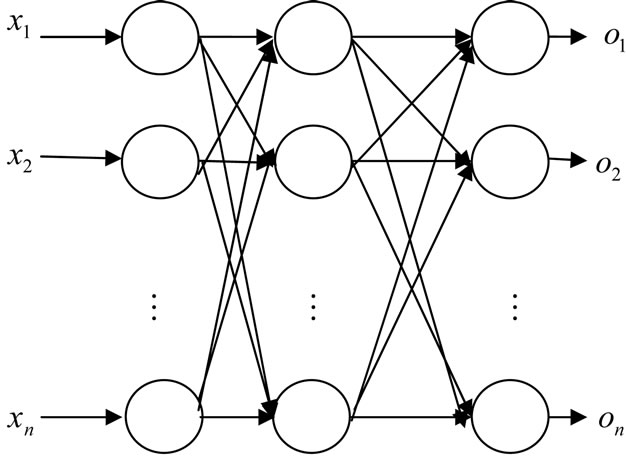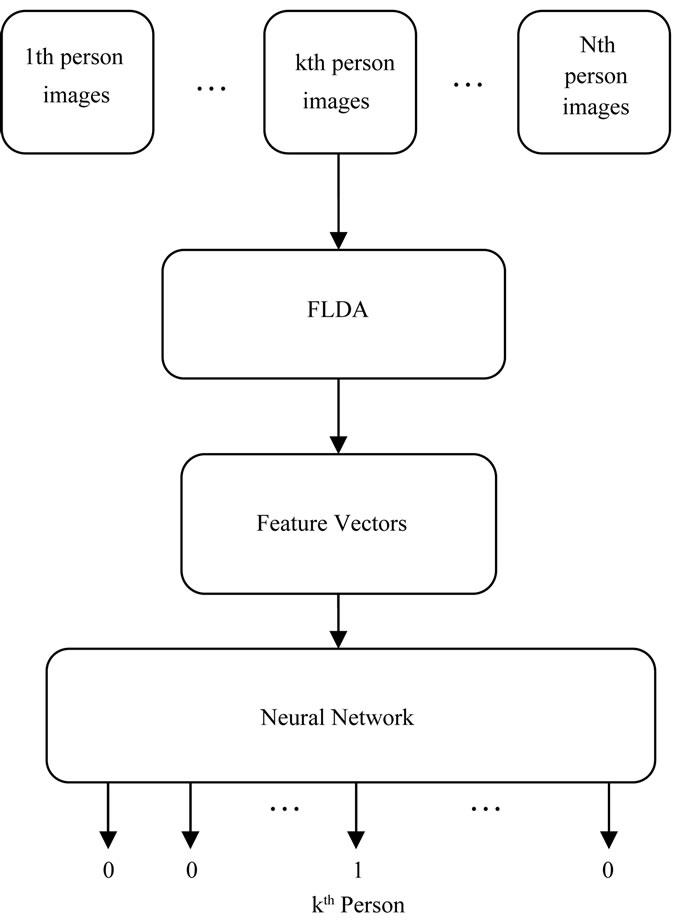Illumination Invariant Face Recognition Using Fuzzy LDA and FFNN ()
1. Introduction
Face recognition has become one of the most active research areas of pattern recognition since the early 1990s, and has attracted substantial research efforts from the areas of computer vision, bio-informatics and machine learning.
Illumination is considered one of the most difficult tasks for face recognition. The illumination setup in which recognition is performed is in most cases impractical to control, its physics difficult to accurately model and face appearance differences due to changing illumination are often larger than those differences between individuals. Reliable techniques for recognition under more extreme variations caused by pose, expression, occlusion or illumination is highly nonlinear, have proven elusive [1].
In this paper, we outline a hybrid technique for illumination normalization, after the Histogram truncation was applied to input face images, the Homomorphic filter was used for normalization. Then face recognition is performed with two major steps. In the first step, some useful features of the image are extracted. In the second step, on the basis of the extracted features the classification is executed.
Fuzzy LDA (Fuzzy Fisherface) recently, was proposed for feature extraction and face recognition [2]. Fuzzy LDA computes fuzzy within-class scatter matrix and betweenclass scatter matrix by incorporating class membership of the binary labeled faces (patterns).
Finally extracted features were considered as inputs to classifiers. In this paper well-known classifier, Feedforward Neural Networks were employed as classification.
Then rest of this paper is as followed. The preprocesssing step is initiated in Section 2 then Fuzzy LDA is introduced in Section 3. Section 4 describes classification and Section 5 determines our experimental results on ORL dataset, and Conclusions is given in Section 6.
2. Illumination Normalization Technique
In this stage, in order to boost the result of normalization, we first truncated a specified percentage of the lower and upper ends of an image histogram.
In fact, several studies have shown that histogram remapping in conjunction with photometric normalization techniques results in better face recognition performance than using photometric normalization techniques on their own.
In the next step, Homomorphic filter as a renowned illumination reflectance was used. And then filtered face image is considered as input of feature extraction module.
Homomorphic Filters
Homomorphic filtering (HOMO) is a well known normalization technique, which improves the appearance of an image by contrast enhancement and gray-level range compression.
Consider an image, f(x, y), which can be stated as the product of the illumination i(x, y), and the reflectance component r(x, y) as follows [3]:
 (1)
(1)
Then input image is transformed in to the logarithm domain in order to achieve frequency components of the illumination and reflectance separately:
 (2)
(2)
Then:
𝔉{ z(x, y)} = 𝔉 {ln f(x, y)}
= 𝔉 {ln i(x, y)} + 𝔉{ln r(x, y)}
Or:

where Fi(u, v) and Fr(u, v), in Equation (2) are the Fourier transforms of the term defined.
The Fourier transform of the product of the Z(u, v) and filter function H(u, v) can be expressed as:
 (3)
(3)
In the spatial domain:
s(x, y) = 𝔉–1{S(u, v)}
= 𝔉–1{H(u, v). Fi(u, v) + H(u, v). Fr(u, v)}
Finally by letting
i(x, y) = 𝔉-1{H(u, v). Fi(u, v)}(4)
r(x, y) = 𝔉-1{H(u,v). Fr(u, v)}
The equation becomes:
 (5)
(5)



where i0 and r0 are the illumination and the reflectance components of the output images. After z(x, y) is transformed into the frequency domain, the high frequency components are emphasized and the low-frequency components are reduced. As a final step the image is transformed back into the spatial domain by applying the inverse Fourier transform and taking the exponential of the result.
This method is based on a special case of a class of systems known as Homomorphic system. The filter transform function H(u, v) is known as the Homomorphic filter [4] .
3. Fuzzy LDA (FLDA)
In Fuzzy LDA, which also was called Fuzzy Fisher Face method, the basic LDA is changed. The modification is the introduction of fuzziness in to the belonging of projected vector to the classes which solves binary classification problems. In conventional LDA approach, every vector is supposed to have a crisp membership. But this does not take into account the resemblance of images belonging to different classes, which occurs under varying conditions. In FLDA, each vector is assigned the membership grades of every class based upon the class label of its k nearest neighbors. This Fuzzy k-nearest neighbor is utilized to evaluate the membership grades of all the vectors [5].
 stands for the membership grade of
stands for the membership grade of  vector in the
vector in the  class and satisfies two obvious properties:
class and satisfies two obvious properties:
 (6)
(6)
 (7)
(7)
The class labels of the k vectors located in the closest neighborhood of each vector is collected during the training phase. Then the membership grade of  vector in the
vector in the  class is evaluated as follow [5]:
class is evaluated as follow [5]:
 (8)
(8)
In the above expression  stands for the number of the neighbors of the
stands for the number of the neighbors of the  data (pattern) that belong to the
data (pattern) that belong to the  class.
class.
The moderated membership grades are used in the computations of the statistical properties of the patterns. The mean vector of each class is obtained from the below equation [6]:
 (9)
(9)
Then, the corresponding fuzzy within-class scatter matrix and fuzzy between-class scatter matrix can be redefined as follow [7,8]:
 (10)
(10)
 (11)
(11)
where  is the mean of all samples. Our optimal fuzzy projection
is the mean of all samples. Our optimal fuzzy projection  follows the expression:
follows the expression:
 (12)
(12)
It is difficult to directly calculate  because that
because that  is often singular [6].
is often singular [6].
For tackle this problem, PCA is used as a dimension reduction step and thus the final transformation is given by the following matrix,
 (13)
(13)
4. Classification
Feedforward Neural Networks
Neural networks have been a much-publicized topic of research in recent years and are now beginning to be used in a wide range of subject areas. Having high computation rates, neural network is used as classification. For this purpose each input pattern is forced, adaptively, to output the pattern indicators that are part of the training data. Feed-forward networks, sometimes called multilayer perceptrons (MLP), are trained adaptively to transform a set of input signals, X, into a set of output signals, O [9,10].
Feedback networks start with an initial activity state of a feedback system, and after state transitions have taken place, the asymptotic final state is identified as the outcome of the computation [11].
Figure 1 shows the architecture of the system for face classification. After calculating the features, the feature projection vectors are calculated for the faces in the database. These feature projection vectors are used as inputs to train the neural network. Figure 2 illustrates the schematic diagram for the training phase. In test phase, image’s feature projection vector is calculated from the feature space. These vectors are fed to the neural network and the network is simulated by them, where the network outputs are compared. The new face’s class is determined by considering maximum output of different classes in which the class with maximum output clarify test image’s label.
The two activation functions  (input layer to hidden layer) and
(input layer to hidden layer) and  (hidden layer to output layer) are used which are logistic functions:
(hidden layer to output layer) are used which are logistic functions:
 (14)
(14)
 (15)
(15)
 and
and  are inputs for hidden layer and output layer respectively.
are inputs for hidden layer and output layer respectively.

Figure 1. Architecture of FFNN for classification.

Figure 2. Training stage for neural network.
5. Implementation and Results
The ORL database consists of 40 groups [12], each containing ten 112 × 92 gray scale images of a single subject. Each subject’s images differ in lighting, facial expression, details (i.e. glasses/no glasses) and even sliding. Some of the database’s images are illustrated in Figure 3.
5.1. Preprocessing Step
Figure 4 shows an original image from ORL database and its histogram respectively. This image is chosen spe-